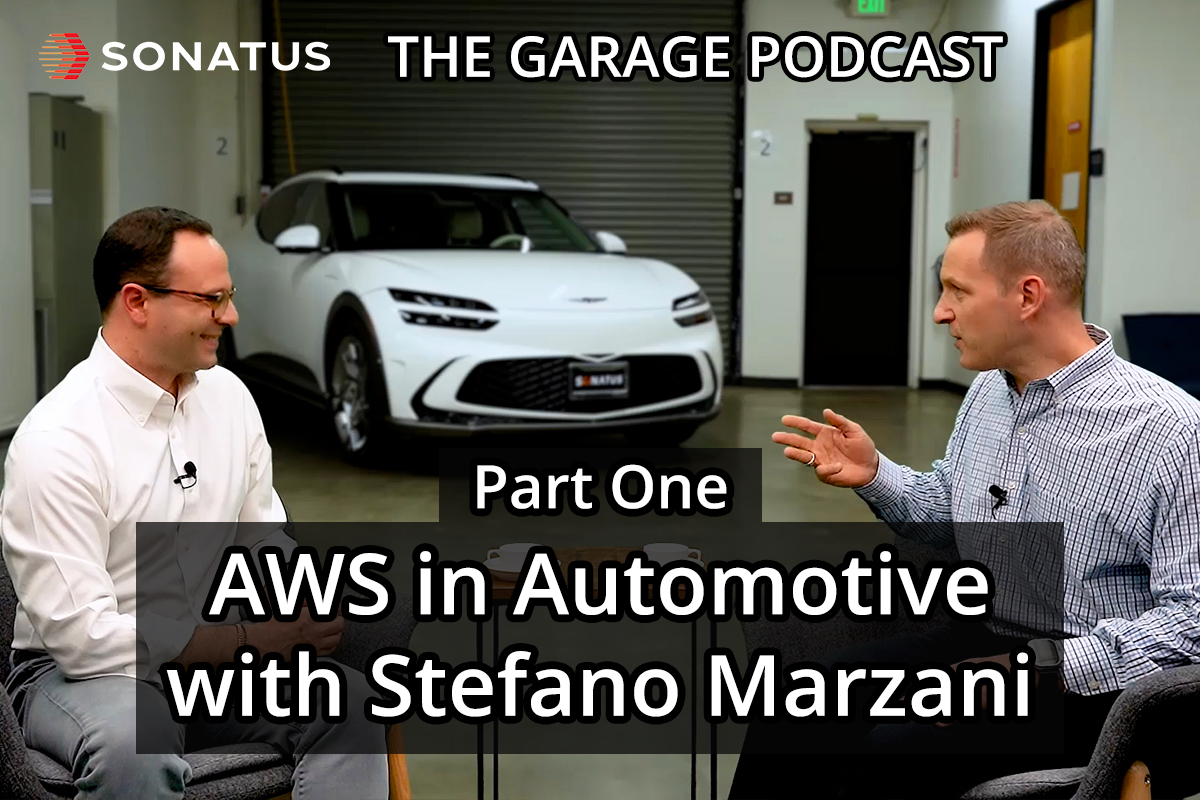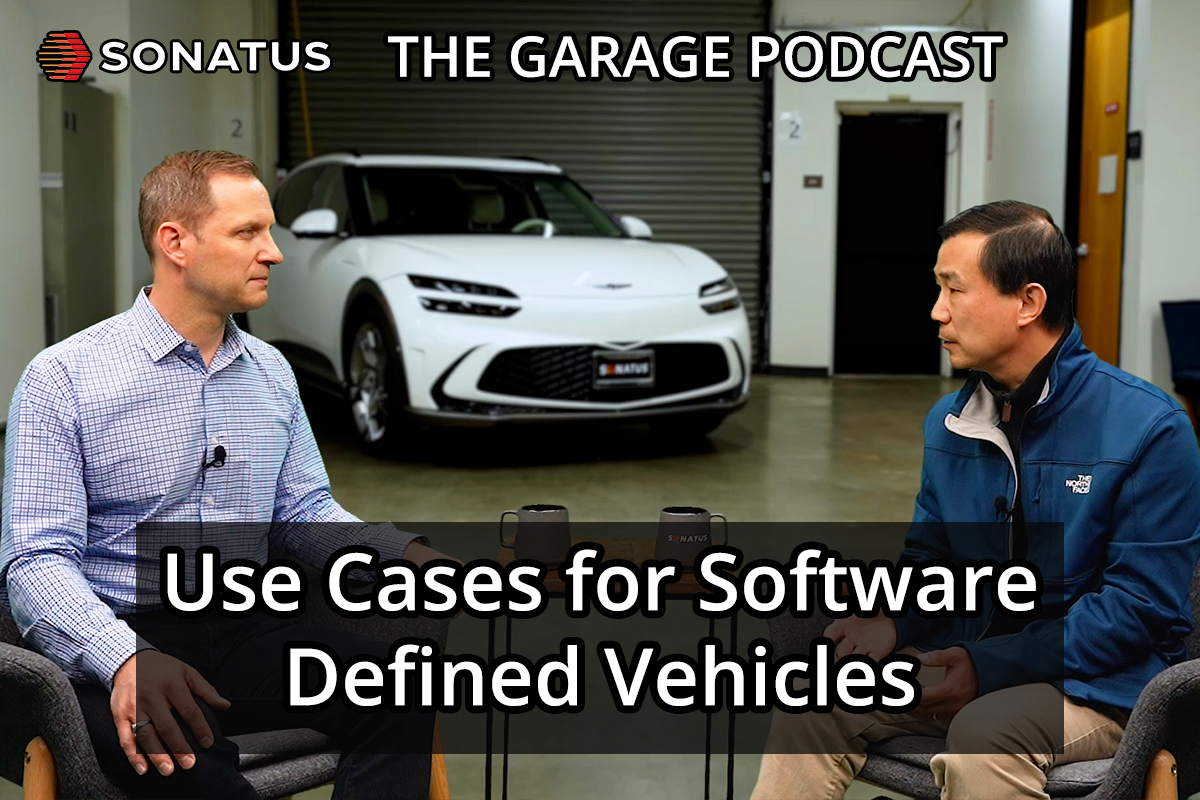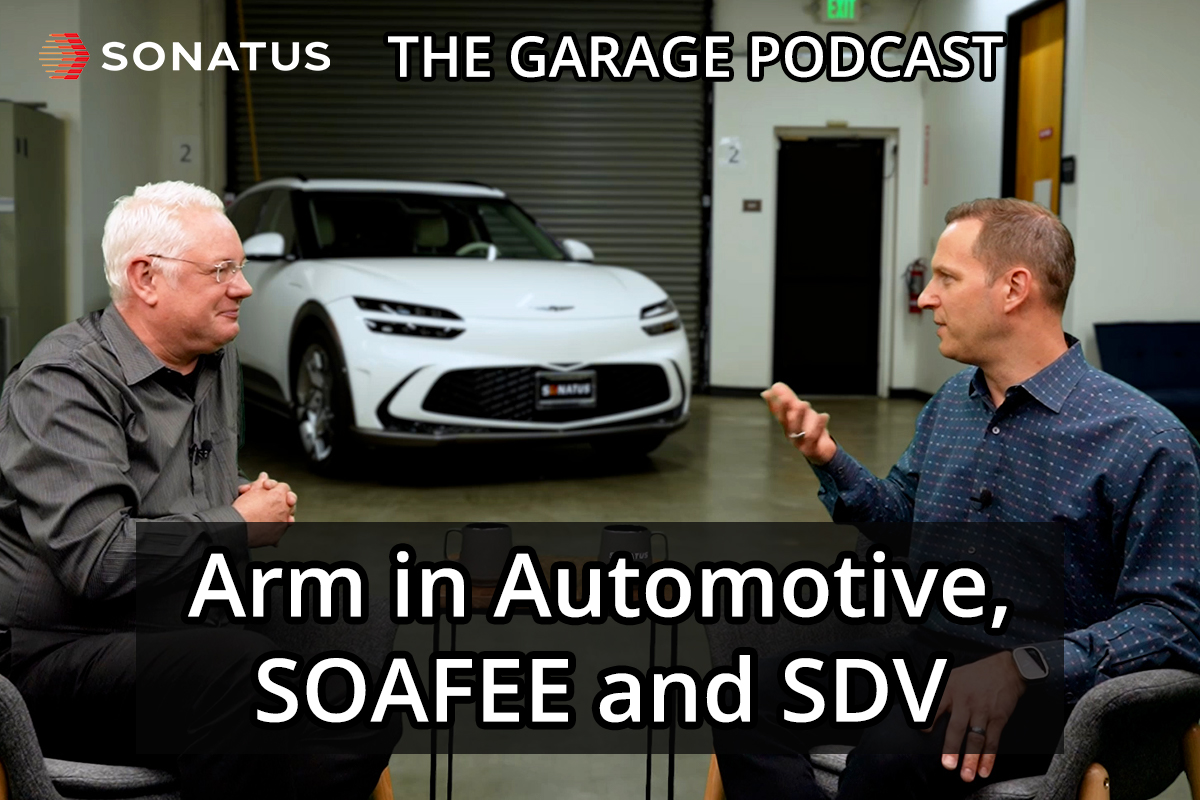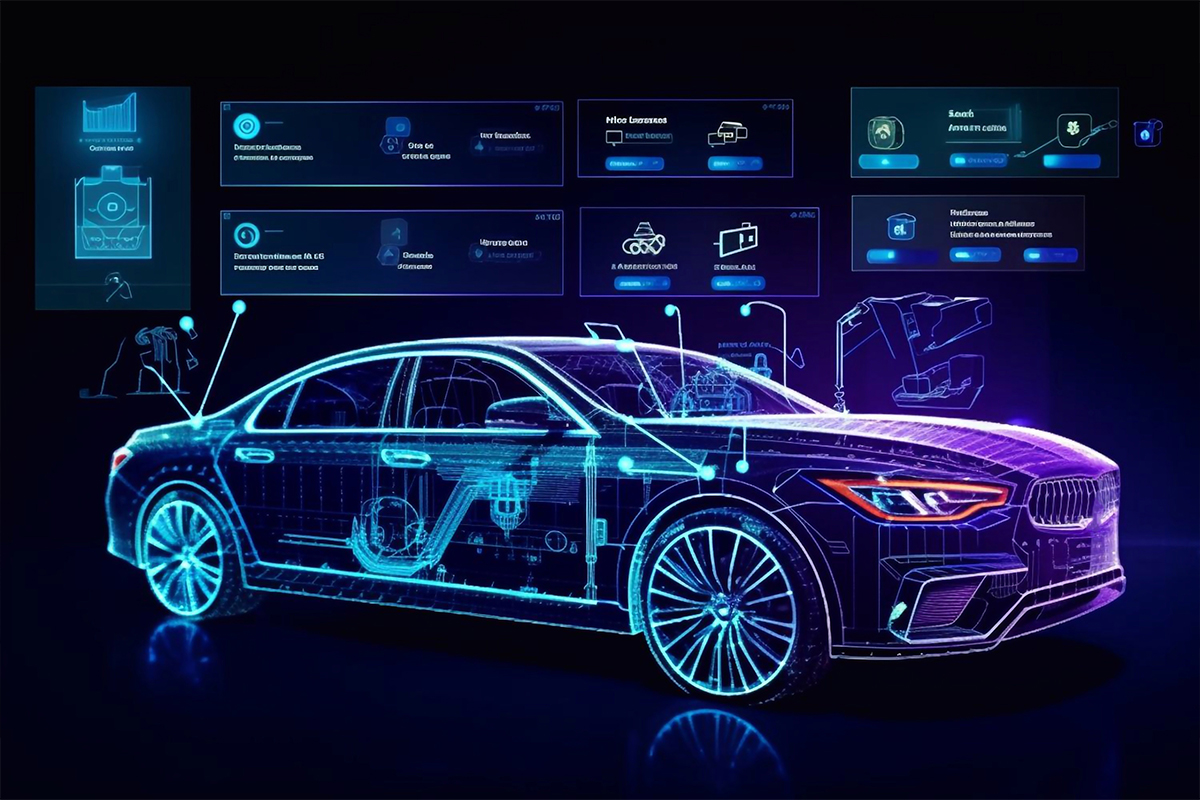The Garage Podcast : S1 EP5
Talking SDV with SBD Automotive [Live at AutoTech: Detroit 2023]
We hear from leading automotive industry analyst SBD Automotive, with guests Andrew Hart, CEO and Alex Oyler, Director, America joining host Dr. John Heinlein, Chief Marketing Officer from Sonatus. This wide-ranging conversation touches on the journey to software defined vehicles including motivations, challenges, benefits, and balancing in-sourcing and out-sourcing.
Listen to audio only version:
Episode Transcript | Talking SDV with SBD Automotive
Table of Contents
- Overview
- Meet the guests from SBD Automotive
- Fun facts about our guests
- About SBD Automotive
- Why are Software Defined Vehicles Important?
- The Parable of the Elephant
- The journey towards SDV
- The current status of the journey
- The balance of in-sourcing and out-sourcing
- Focusing on OEM differentiation
- Complementing OEM teams
- The unmet need served by SDV
- Data and telecom operators and vehicles
- Features as a service and revenue creation
- Serving different kinds of customers
- Conclusion
Overview
JOHN: Today in The Garage we’re filming live from AutoTech: Detroit with SBD Automotive. Let’s go! Welcome to The Garage. Today, we’re live at AutoTech: Detroit, Michigan’s leading tech show for automotive with SBD Automotive.
Meet the guests from SBD Automotive
JOHN: We’re so excited to have joining us today, Andrew Hart, the CEO of SBD, and Alex Oyler, one of their analysts. Guys, welcome to The Garage.
ANDREW: Thank you so much for having us here.
JOHN: So I always like to have our guests introduce themselves. Tell us a little bit about you and what your roles are at SBD.
ANDREW: Yeah, absolutely. So I’m Andrew Hart, CEO of SBD Automotive, and we’re a research and consultancy company that really specializes around CASEs technologies, so connected, autonomous shared, and electric cars. And we primarily work with car companies helping them with this huge transition that they’re having to make, from what was relatively simple cars to what we’re seeing now, have a huge amount of complexity and strategic difficulty in deploying new technologies.
JOHN: Fantastic. And Alex?
ALEX: Thanks, John. Yeah, I’m Alex Oyler. I’m the director of SBD North America. I had previously spent the last eight years of the company focusing on kind of the building momentum behind what has now become the software-defined vehicle. So in 2015, that was really focused on kind of the emerging cybersecurity needs, and that built into over the air software updates, and then really the competitive pressure that somebody like Tesla brings to really rethink how you’re building the cars. So that’s something we’ve kept our finger on the pulse of overall and a personal passion project, I would say for me, but now I’m the director for SBD North America and manage all of our business here in the United States.
Fun facts about our guests
JOHN: Fantastic. So tell us, just for fun we always like to ask our guests: tell us something about you that people might not know, something interesting.
ANDREW: Oh, well, I used to live in Argentina. I grew up in Argentina.
JOHN: That’s pretty interesting.
ANDREW: Six years.
JOHN: You wouldn’t know from the accent.
ANDREW: No, you wouldn’t, you wouldn’t know. And to me, that was just the most amazing experience of living up near the Andes. So my first form of mobility that I remember is being on the back of a horse riding up the mountains. Yeah.
ALEX: And for me, I grew up in rural Kansas, kind of, not on a farm, but on a decent plot of land, so a different bringing-up than a lot of folks. But, you know, in 2015, I took the leap and joined SBD Automotive and a few years later, I ended up living in one of the biggest metro areas in the world in Nagoya, Japan. So I’ve been able to enjoy the diverse range of mobility experiences between rural America and some of the densest places in the world. So that’s a little, little unknown fact.
JOHN: Well, it’s only fair I guess, I’ve got to share something about me. So let’s see, I guess it was 2006. I lived in Japan for about six months when I was at a semiconductor startup called Transmeta that you may know of. Once upon a time it was a pretty big deal, where we made Intel-compatible processors in a very fun way. So there’s my fun fact for the the day.
ANDREW: Very good.
About SBD Automotive
JOHN: So I think firstly let’s begin by talking about SBD a little bit. You mentioned kind of at a big picture what they do and I think you’re really well known in the industry but for any of our viewers who may not know SBD, tell us a little bit about the scope of what you do and what you specialize in.
ANDREW: Yeah. So two thirds of our work is bespoke consulting for car companies, really helping them understand how to transition and that can be anything from understanding consumer needs, technical roadmaps, understanding regulatory requirements, and bringing that all together into a clear picture. I think the car industry is going through such a big transformation, when you look at the push towards electrification, the push towards digitalization towards autonomy, that it can be very difficult to build up a clear idea of what needs to be done, and sometimes, within big organizations, you get a little bit blinded by what’s happening internally, that you lose track of what’s happening externally. So we tend to be their external eyes in that and we help them stay grounded to ultimately what customer wants, but also what’s happening amongst their competitors. So about two thirds of our work is consulting. The other third is kind of off the shelf research and reports. So we publish around 50 titles a year. And that’s, again, all around clarity and creating a kind of common understanding and language that our customers can look at and refer to and say yes, now we know we know what we’re talking about, and software-defined vehicles has been one of those areas that’s meant a lot of things to a lot of people. So one of the first reports that Alex wrote when he joined SBD was a common bible of software-defined vehicles and what that means and what the different levels are, and it’s that kind of clarity that really helps speed up decision making within car companies.
JOHN: Kind of a Rosetta Stone.
ANDREW: Exactly. Yeah, absolutely.
Why are Software Defined Vehicles Important?
JOHN: Yeah. So, The Garage podcast, we focus on advanced software technology. Yeah. So it allows us to focus on a little bit, where you have kind of a broad range. Yeah. We focus a little bit into that area. I think that software-defined vehicle area you mentioned is so important. We always ask our guests to start by saying, why do you think the software-defined vehicle is compelling and important to the industry?
ANDREW: I think it’s almost no longer a question whether it’s compelling, it’s almost inevitable, right? I think we live in a world where the digital and the physical world are just naturally melded together in so many different parts of our lives. The car is one of those areas that hasn’t yet fully kind of coordinated between those two worlds. And car companies have seen that disruptors are coming in, and developing new types of experiences, new types of business models that are leaving them behind. And so whilst 10 years ago, success was measured by how many cars you sold, that definition of success has fundamentally changed. And Tesla has stripped that away, so we can sell a 10th of the number of cars as you guys can, and yet be worth 10 times more. So there’s no question now in any of the OEMs’ minds about the need to go in the direction of digitizing themselves and their products. It’s more a question of how and who to work with. So I’m not sure if that’s…
ALEX: Yeah, and if I, if I can indulge a little bit of a metaphor here. I like to think of the automakers a bit like artists, right? That are working with certain medium today. I mean, maybe they are, they’re sculptors, maybe they’re glass blowers, whatever the case may be, but what the software-defined vehicle is for them is actually completely changing the medium with which they’re working. So let’s say that the software-defined vehicle is a canvas, they have to relearn how to mix those oils and paints together to create new colors. Yeah. Whereas in the past, maybe they bend metal – well, they did bend metal, right – To make the cars it’s more than that now, and so it’s, it’s not just one thing, it’s relearning how to, to the fundamentals of the business.
ANDREW: Yeah. So a mindset change, isn’t it?
ALEX: Correct.
The Parable of the Elephant
ANDREW: That maybe a couple of years ago, we would have seen this through the lens of technology, now it’s much bigger than technology. And that’s part of the challenge. If it was just technology, we would have it by now. But it’s ecosystem, it’s organizational change, it’s business model changes. It’s so many different facets.
JOHN: And I think everyone when they hear software-defined vehicle, it’s like that, the parable of the elephant. You know, the parable of the elephant?
ANDREW: No.
JOHN: Five blind men come upon an elephant and one guy comes to the leg of the elephant. He says, “Oh, it’s a tree.” And one guy comes to the trunk and says, “Oh, it’s a snake.” One guy comes to the side and says, “Oh, it’s a wall,” but it’s the same thing. It’s just coming at it from a different perspective. So I- think when you talk about software-defined vehicle, I think people hear and think different things. One person thinks, OTA updates, or one person thinks, oh, you’re gonna charge me for services? One person thinks some of the vehicles are gonna get better, or, and I think they’re all right. But they’re kind of coexisting. How do we, how do we get through that and get people to realize both consumers I think, as well as tier ones and OEMs, that there’s a full transformation that has to happen, right?
ALEX: Yeah, and I think it’s, I agree with you. And if we maybe we start with an inward look, and I think that’s counterintuitive to maybe how it should be. You always want to start with the consumer what they want and evolving the product to sort of what their demands are. So in the SDV report that Andy was talking about earlier, one of the things that we tried to do to bring clarity is actually define what the software-defined vehicle is, and of course, it’s more than just the technology. Yes, you’ve got the electronics, electrical architecture, and you’ve got the software that’s running on top of that, and the abstraction between those. But beyond that, there are so many enablers and changes in the business that have to happen to make the software-defined vehicle a reality. The development process, the development tools, the organization structure. All of these are important elements that have to be changed in order to make sure that the vehicle not only comes to market, but that it can be iterated and monetized and value being driven to that customer over the lifetime of the car.
JOHN: That’s great. You know, we’re voracious readers of your reports at Sonatus, so we really appreciate your hard work.
ANDREW: You’ve got a copy on your bedside table?
JOHN: No, maybe not that. My wife might not go for that.
ALEX: Coffee table at least!
JOHN: Yeah, there you go, coffee table.
The journey towards SDV
JOHN: So you know, I’m happy to say we’ve had a lot of fantastic guests. Recently we had Stefano Marzani from AWS. I know you know him.
ANDREW: Stefano is great, yeah.
JOHN: Right, yeah. And I was recently watching an episode of his podcast called “All Things Automotive,” where you were a guest about a year or so ago, and I really appreciated a point you made, which is talking about the journey, if you will, to software-defined vehicles, not as if a binary bit of a bit flip. But rather a continuum where there’s, there’s gradations of the kind of the full promise. So I’d love to hear your perspective both about that spectrum in general, maybe you could reintroduce that, but also thinking about it one year on. How have you seen the industry and OEMs through that journey? That complicated journey?
ANDREW: Why don’t you talk through the spectrum? And then we’ll talk about where we are.
ALEX: Yeah, absolutely. So there’s, there’s kind of this 40,000 foot view of, of that journey of the software-defined vehicle and we’ve defined it in four stages or 1.0, 2.0, 3.0, 4.0. So “vehicle 1.0” is kind of, you know, the standard car you see on the road today. A bunch of ECUs integrated together by a bunch of disparate teams that you can’t really iterate or update, update the software capability in any meaningful way. The first real step on that software-defined vehicle journey that we’ve seen from the mass market is sort of towards digitalization or “vehicle 2.0”. In that case, really, we saw the ability to update software within the infotainment system to deliver new experiences through connectivity, and then you know, to drive additional sources of revenue for automakers through things like subscriptions. That’s really been the journey over the last 5 to 10 years, and where we are now is what we’ve called “vehicle 3.0” or the updatable vehicle. In this context, the car, yes, you know, the ECUs are, they can be updated over the air but it’s really kind of a stepwise journey towards software-defined vehicle because it’s not really scalable software development. It’s very difficult to add features to these ECUs and more than anything, it’s difficult for automakers to completely re-change their architecture or build from the ground up a brand new architecture that’s capable of really representing the ideal software-defined vehicle. So right now it’s really kind of a Frankenstein of the updatable vehicle, and then what we see at 4.0 is the software-defined vehicle where a majority of the functions in the car can be updated over the air, whether that be the configuration, or the execution of them, the HMI, you know, the quality and making sure that the vehicle is responsive, not just to the driver to make a personalized experience, but also that that service improves over the lifetime of the car.
ANDREW: And the architecture is a lot more sophisticated, I’m guessing at that stage. You’ve got service-oriented architectures, you’ve got much more on the edge, so it’s, it’s a more, seems like a more multifaceted type of architecture.
ALEX: That’s right, and maybe the biggest thing in all of this is the maturity of the tool chain, right? Because, you know, before now, the traditional automotive supply chain, and a lot of the software suppliers that operate in that were really developing tools and products that are oriented to that “vehicle 1.0”, “vehicle 2.0” mindset. So it’s taken time for the software supply chain to say, we need to completely rethink how we’re kind of supporting our customers with the tools that they need to kind of go further along on this journey. And that’s where companies like Sonatus come into play, where you provide tools for OEMs to more sustainably and more scalably implement software.
JOHN: So you know, I think likewise, when you talk about that development tools, I think the idea of developing software that works on one exact hardware block into perpetuity is a completely different challenge than anticipating….we were on a panel yesterday talking about how you have to anticipate the applications you don’t even know about. Yeah. As opposed to what you’re doing just today.
The current status of the journey
ANDREW: But you asked about kind of where we are right a year on. I think if you look at a macro-level within the industry, OEMs fully embrace this. You know they’ve, they’ve made a number of announcements of huge programs, massive organizational changes, big new teams being built up, commitments to build their own OS’s, commitments to speed up the digitization. I think that rush over the last 12 months has hit a few brick walls, where they’ve started to realize what actually this isn’t about throwing money or people at it. I think some of those OEMs that made big proclamations and took on ambitious levels of in-sourcing are now starting to realize that there’s a fundamental change in mindset and culture in the environment that’s required within their organizations to be able to support their technology strategies. And that’s the hard bit. That’s where a lot of the work now is starting to focus on is: how do you change that culture, that agility, that way of working, while still operating business as usual? You know, they still need to make cars, and most of those cars today aren’t software-defined in the way that Alex just described it. So they need to keep both their current businesses moving to sell cars to make money to make profit, while somehow carving out a new part of the business, which is a completely different being with a different DNA, different way of working, different way of partnering. And that kind of slight schizophrenia within an organization can create fractures and tears, and can make things painful. And we’re seeing a lot of pain within the OEMs, which is natural.
The balance of in-sourcing and out-sourcing
ANDREW: I think the key is to find the right balance, the right speed, the right partners, the right business model, so that you don’t break what you’ve got, but you still make good steps forward. And that’s what we see right now a year on, a lot of OEMs are trying to find the right…
JOHN: Kind of growing pains in the process, and you mentioned a couple of things there. One is you mentioned the right partners and then you also mentioned earlier about bold steps and extensive insourcing, and I think if I, if I slightly oversimplify what I think I’ve seen over the past couple of years, is the vast majority of certainly your larger OEMs are saying, “I’m going to do everything myself.” You see CARIAD, you see Woven Toyota and so on, where they’re largely trying to take care of everything themselves. But it seems to me, you’re now seeing a shift back where they’re saying, well, actually, there’s some challenges there, and I think there feels like there’s an opportunity for sensible partnerships to solve parts of the problem. Yeah. Is that what you’re seeing?
ANDREW: I think we, I think what you generally see, and we’ve seen for the last 15 years, especially since the advent of connectivity in cars, is a regular swaying from outsourcing to insourcing within the OEMs, and over-swinging on both sides.And so OEMs that have kind of committed a lot more to insourcing. Normally, what happens is that they face challenges, executives start to get a bit nervous about how much money is being spent, they start to question why so much has been done in-house, and they’ll swing and sometimes they’ll over swing. On the other side, you’ll see kind of teams that suddenly feel tied down to one supplier or one partner and feel that, oh, we should be more independent, and so they start swinging the other way. So there’s always this swinging, I think what they’re trying to reach is a good balance, and few OEMs have achieved that, but it takes a lot of, I’d say, maturity and knowledge at the executive level to trust that that’s the right way. And that’s the hard part because executives within most of the big OEMs don’t have a strong background in software. So they see things through kind of different lenses and so when you say to them, okay, is this the right strategy? It’s like, “I don’t know”. So the temptation is to swing another way or another way or someone else comes in and says, oooh, we should do that, we should partner with them.
Focusing on OEM differentiation
ALEX: Yeah, maybe the key insight or the key recognition that’s happened now, and it was always there at certain levels, but I think there is now a kind of a lockstep alignment across a wide majority of the mass market OEMs is, we need to focus on building differentiating software experiences. So once they say, these are our brands, for each brand, this is our identity for that brand, and here are the features, the experiences, the capabilities that we’re building out that feed into that sort of that brand value. That’s the stuff that they want to in-source, right? That’s the that’s the IP that they want to own, and, and now the thinking is going towards, okay, we will have our software developers focus on iterating on that and building kind of mature iterative experiences, and then we’ll work with our partners to integrate different parts of that non-differentiating enablement stack, like the tools and the platforms.
ANDREW: But it probably isn’t a one size fits all, right? I think every OEM is going to arrive at slightly different conclusions as to what’s the right balance, and what’s the right partnership network based on what their own strategic goals are, what even what their, their reach is, their volumes, and so many of these things come into play that says, okay, this is the right level of software-defined vehicles for us, and this is the right strategy for us based on what we want to achieve. So yeah, it’s gonna be, it’s gonna be interesting as different OEMs try different things.
JOHN: I think so. And you mentioned differentiating and non-differentiating. We make a lot of infrastructural components, underlying technologies that we think are and are super important to enable the kind of evolving software-defined vehicles you mentioned, but nobody’s gonna buy a car because of the infrastructure. But the infrastructure is critical. Yeah. So why, why do that in-house? When there’s so much differentiating stuff that you need to do, as Alex said, to provide your identity and your unique value prop? So I think that’s where we feel like there’s some happy medium that can be achieved.
Complementing OEM teams
ANDREW: Yeah, I think there are other factors beyond cost and differentiation that have played into their historical decision making, concerns around security, the agility, or lack of agility, that there’s a bunch of other factors that determine whether they should go in-house. Sometimes it’s a matter of pride, right? Sometimes there are teams that want to be able to demonstrate that they can do that, then politics plays a big part of it. So it is quite complicated, and from the outside, it can be very difficult to see how they landed at that decision, but normally, when you sat down or when we worked with them, you can go in and start to prop back how they landed where they did. Whether or not that’s the right decision, that’s where they are, and that’s where they started from. Yeah.
JOHN: Yeah, when we, when we talk with OEMs, and tier ones, both, there’s always that that sort of pride issue, or you know, they want to make sure that they show their own differentiation. And so a lot of our focus is showing them that we’re really enabling them. We’re very high-paid stepstool, I guess, or something like that, if you think about that analogy. Where we’re really helping them to get – our slogan is accelerating vehicle software innovation for reason – we’re not trying to replace them. We’re not trying to eliminate them. We really want them to succeed faster. Yeah. And achieve their goals quicker.
ANDREW: Yeah.
The unmet need served by SDV
JOHN: So pivoting over to another topic is, I’d love to think about if you step back and say, what are the killer apps for software-defined vehicle or perhaps another way to think about is, what are the key unmet needs that you see that are still out there that can help to drive this forward? What do you see is the focus right now?
ANDREW: From an ecosystem point of view and a supply chain point of view, one of the unmet needs that OEMs have, is knowing how to do all of this transformation in the right order, in the right way, that isn’t going to sink them. So if you think of, you know, right now, the priority is mass electrification, that’s eating into their margins, making this profitable, but they know they have to do that. And on top of that, they’ve been told, ah, you’re gonna have to digitize. You’ve got to become, you know, software-defined to be able to deliver a lot of these things. And you got to develop autonomy, and you got to do this. And now AI is coming along, and there’s a lot of one thing over the other, that’s creating this massive amount of pressure and cost and affecting their margins, right? So I think, as an ecosystem, recognizing their reality and being able to demonstrate how software-defined vehicles can actually save them money, and how to calculate that ROI, and build that into their equation. So that they don’t feel like this is just cost, cost, cost, cost. So I think that to me is an unmet need right now, is a) recognizing that they don’t need everything in every vehicle, and b) demonstrating how what they do need is going to save them money over time. I haven’t seen many suppliers in the ecosystem, being able to show that, from an OEMs’ point of view, that really resonates.
ALEX: I think there’s also, you know, part of that really is having a better set of tools to democratize value creation. I feel like an MBA grad saying that. To democratize value creation amongst the different teams within the OEMs, to take advantage of the software-defined vehicle, right? So if you have, you know, a much more capable compute platform in the car that’s running, you know, all these different enablers, you know, data collection platforms, or aggregation, platforms, etcetera. There might be organizations within the OEM that can create value or optimize costs from that, that don’t even know it’s there, right? So, you know, just having everybody aware of what the vehicle is capable of, and then giving them the tools to, you know, optimize their costs or create value with that is kind of low hanging fruit overall, I would say.
Data and telecom operators and vehicles
ANDREW: One example from that that’s come out in this event has been around, there’s been a really strong presence of telecom operators. Yeah. And the reason for that is there’s so much more data coming in and out of the car, but that data is normally linked to a contract within the OEM. But the uses of that data within OEMs can be really varied. You know, it can be after-sales team or an engineering team, it can be the, you know, the purchasing team, if it’s selling data, or whatever it is. Each one of those is a separate business model. So being able to help the OEMs split up, what is one big data pipe into smaller chunks and find ways of creating more distribution within the OEMs have ownership of that, and allowing that contract to be more flexible, than maybe what it is at the moment. That’s an unmet need, I think.
JOHN: It’s a recurring problem where when there’s a shared service, and you see this with development tools, you see it in lots of other areas where, well, one BU has to bear the cost, sign the contract. So he doesn’t want to be stuck with it, but central purchasing is like, well, they have to create a kind of a keiretsu of multiple companies, so I think this is a real challenge. We’ve demonstrated on our, a lot of our products, the ability for once our product is deployed, you can actually put it in the hands of multiple groups simultaneously in a non-conflicting way. And by doing that, hopefully make the case to every one of them and purchasing at the same time, that this is going to benefit all of you, and no one of you has to take the bets.
ANDREW: Yeah. And it’s interesting, I think software-defined vehicles breaks a lot of the classical commercial models, and the kind of pyramid-type structure that we had before. And in doing so, I think we’re going to have to find much more creative commercial agreements between suppliers and within organizations between different teams to be able to make all this work. So I think that some of the growing pains that OEMs are also going through on the back end.
JOHN: Speaking of the telecom and the data aspect, which is very close to our hearts, we do a lot of interesting work with creative data access, one of the fun things we have developed is a tool that allows multiple data gathering policies to coexist. So you could almost take each of those policies and provide billing to the respective group within the company that provided it. To allow that kind of division, if you will, of the bill. So it’s interesting and I did observe that all three of the big, big telecom providers are sponsoring the show. It’s, it’s an interesting observation.
ANDREW: Yeah, they come in heavy. Yeah. It’s like the 1990s again.
Features as a service and revenue creation
JOHN: What about you Alex? What about unmet needs or killer apps you’re seeing that are driving SDV?
ALEX: Yeah. Well, I ultimately and there’s a lot of ways that it’s being called: features on demand, features as a service, subscription-based revenue. Ultimately, it’s really about creating new revenue streams from existing assets and platforms. The software-defined vehicle is the killer app for that, but the threat is a bit more existential than maybe it has been over the last few years. The costs of electrification for these OEMs and the amount of capital that they’re pumping into electrifying their portfolio is really staggering. I mean, 10 zeros, 11 zeros, in some cases, and, and you know, if you look industry wide, it gets even more ridiculous. So you know, there’s a real strain on the OEM business model, and to keep, you know, cars being produced that are profitable, that go into consumers’ hands that are supported and scale well across the globe, while also kind of transitioning their existing platforms or their existing portfolio to the software-defined vehicle platform. If you look at profitability targets for OEMs, a lot of that hinges on creating these new revenue streams that the software-defined vehicle is really the vehicle for, so to speak. And that’s not that’s not something, you know, rote like the, the heated seats, you know, that’s become a bit of a trope in the industry, right? And maybe, you know, there could be a model in which that makes sense, but if we think about what consumers want today, how they view the purchase of the vehicle, the type of money that they’re paying for that.
Serving different kinds of customers
Ultimately, what has to happen is a reimagination, from the OEMs of the business model with the customer, and then using the software-defined vehicle to differentiate experiences for the different types of customers. Those could be fleet operators, they could be drivers for gig operators. They could be taxi drivers, of course, there’s your personal vehicle buyer. And then within that you’ve got your people who lease your vehicles, who buy them. All of them are paying different amounts of money for different features at different price points in different segments, and they all want different things. So you can really use the software-defined vehicle to differentiate how you offer that. What comes baseline and then what comes on top of that, and then below, what’s happening below that is actually the cost savings of being able to standardize the electronics/electrical platform that’s being offered to all these different customers. So that’s really what it comes down to, at the end of the day for the software-defined vehicle.
ANDREW: I think a killer app to enable that is probably a new customer engagement model. I think most OEMs have only ever sold cars to dealers who have then sold cars to customers. And their relationship with, with consumers have been relatively limited the touch points, and so they haven’t had to learn how to maximize engagement. How to optimize a bunch of KPIs that would deliver the types of ongoing revenue opportunities that companies like Netflix or you know, companies like Apple have gotten really good at doing. They are still quite traditional sales companies from—
JOHN: Sure, and even Tesla is selling effectively direct to consumers…effectively. More so than most. So they have a much more direct relationship with them.
ANDREW: Absolutely, but I think getting much more sophisticated around that whole customer experience and lifetime value is going to mean developing kind of really sophisticated business teams and capabilities and tool sets that can drive KPIs like engagement, like lifetime value, those kinds of KPIs that, that at the moment are a bit foreign to most OEMs.
Conclusion
JOHN: This has been a fantastic conversation, guys. I like some of those last closing points, especially Alex, about the different ways that cars effectively can be used and purchased and paid for and sold. I think that’s compelling. So thank you so much for joining us. Thank you so much.
ANDREW: Thank you for having us!
JOHN: I really appreciate it and continue to be a voracious reader of all your hard work.
ANDREW: Absolutely! Thank you.
ALEX: Appreciate it. Nice to see you.
ANDREW: Thank you.
ALEX: Thank you, John.
JOHN: So thank you for joining us today and this episode of The Garage live from AutoTech: Detroit. I hope you don’t mind the background noise or perhaps you didn’t hear too much background noise, if we’ve done a good job with our sound editing, but we’re so grateful for our guests from SBD Automotive who talked about a wide range of perspectives on SDV and where they’re going in the future. If you like what you’re seeing in The Garage, please like and subscribe and we look forward to seeing you in another episode again very soon. Thanks very much.
Recent episodes

The Garage Podcast
AWS in Automotive with Stefano Marzani, Part 1 of 2

The Garage Podcast
Use Cases for Software Defined Vehicles

The Garage Podcast
Arm in Automotive, SOAFEE and SDV
Related resources

The Definitive Guide to Software Defined Vehicles
These days, the automotive industry is talking about software-defined vehicles (SDVs), but not everyone understands what this means. Don’t all vehicles already have automotive software inside?
The Opportunity and Challenges of Vehicle Data
In our countless conversations with customers, one thing continues to be clear: the increased opportunities from vehicle data will be…